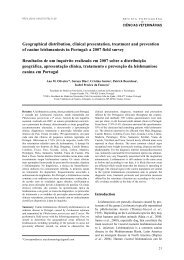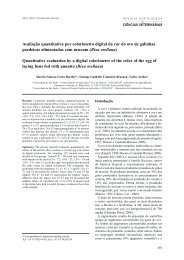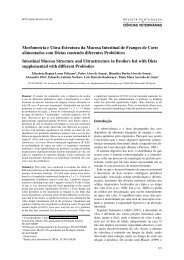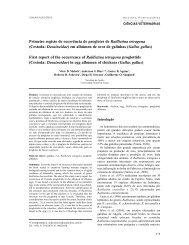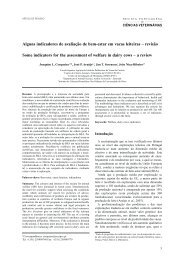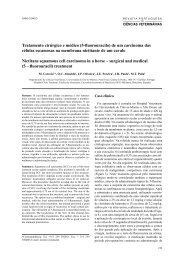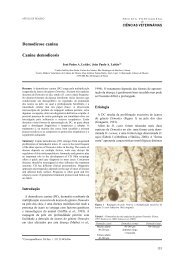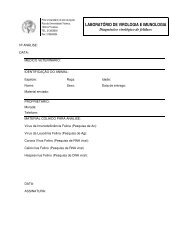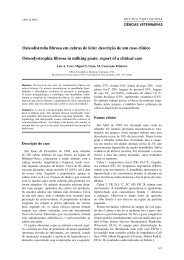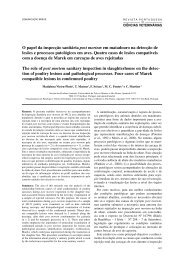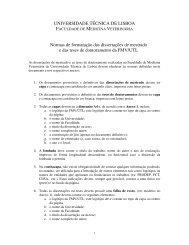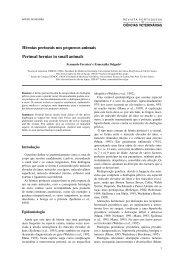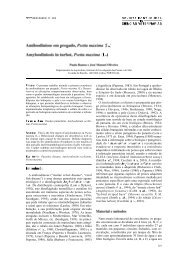Fish vaccination against infections by Streptococcal species and the ...
Fish vaccination against infections by Streptococcal species and the ...
Fish vaccination against infections by Streptococcal species and the ...
You also want an ePaper? Increase the reach of your titles
YUMPU automatically turns print PDFs into web optimized ePapers that Google loves.
Gomes S e Afonso A<br />
Streptococcosis is a bacterial disease mainly caused<br />
<strong>by</strong> streptococci, lactococci <strong>and</strong> vagococci bacteria. It<br />
occurs in both fresh <strong>and</strong> seawater <strong>and</strong> has been a source<br />
of major economic losses since <strong>the</strong> early seventies for<br />
<strong>the</strong> rainbow trout (Oncorhynchus mykiss) <strong>and</strong> marine<br />
fish industry in Asia (especially yellowtail Seriola quinqueradiata)<br />
as well as in <strong>the</strong> United States of America<br />
<strong>and</strong> South Africa. With <strong>the</strong> development of intensive<br />
fish culture practices in Japan, bacterial <strong>and</strong> viral diseases<br />
have spread <strong>and</strong> caused serious problems for culturists<br />
(Kusuda <strong>and</strong> Salati, 1993). The disease, which is associated<br />
with high water temperatures, is now becoming a<br />
serious problem for <strong>the</strong> European trout industry<br />
(Ghittino, 1999). Although streptococcosis outbreaks<br />
have occurred for four decades in Japanese farms, as<br />
mentioned before (Ringo <strong>and</strong> Gatesoupe, 1998), this<br />
disease has been described in o<strong>the</strong>r cultured fish<br />
<strong>species</strong> throughout <strong>the</strong> world, such as hybrid tilapia<br />
(Oreochromis aureus x O. niloticus) <strong>and</strong> striped bass<br />
(Morone saxatilis) in North America, or rainbow trout<br />
in South Africa <strong>and</strong> Australia (Ghittino, 1999).<br />
There has been an important controversy about <strong>the</strong><br />
number <strong>and</strong> <strong>the</strong> nature of <strong>the</strong> bacterial <strong>species</strong> involved<br />
with streptococcosis (Austin <strong>and</strong> Austin, 1999). In early<br />
reports on streptococcosis in fish it was not always possible<br />
to assign isolates to a particular <strong>species</strong>, however<br />
some attempt was made to group fish pathogenic<br />
strains on <strong>the</strong> basis of phenotypic traits such as haemolysis<br />
<strong>and</strong> correlate this characte-ristic with a range of<br />
pathologies (Miyazaki, 1982). Thus, α-haemolytic isolates<br />
responsible for granulomatous inflammation,<br />
β-haemolytic isolates, causing systemic infection with<br />
septicaemia <strong>and</strong> suppurative eye inflammation, <strong>and</strong><br />
non-haemolytic isolates were recognized (Robinson<br />
<strong>and</strong> Meyer, 1966; Plumb et al., 1974; Kusuda et al.,<br />
1976; Minami et al., 1979; Iida et al., 1986; Al-Harbi,<br />
1994; Toranzo et al., 1994). Nowadays <strong>the</strong>re is a general<br />
acceptance for <strong>the</strong> division of streptococcosis into<br />
two forms according to <strong>the</strong> virulence of <strong>the</strong> agents<br />
involved at high or low temperatures (Ghittino, 1999).<br />
"Warm-water" streptococcosis, causing mortalities at<br />
temperatures higher than 15 ºC, typically involves<br />
<strong>species</strong> such as Lactococcus garvieae (formerly<br />
Enterococcus seriolicida), Streptococcus iniae, S.<br />
agalactiae or S. parauberis. On <strong>the</strong> o<strong>the</strong>r h<strong>and</strong>, "cold-<br />
-water" streptococcosis caused <strong>by</strong> Vagococcus<br />
salmoninarum <strong>and</strong> Lactococcus piscium, occurs at<br />
temperatures below 15 ºC.<br />
Toranzo <strong>and</strong> colleagues described <strong>the</strong> first epizootic<br />
outbreak of streptococcosis in turbot (Scophthalmus<br />
maximus) cultured in <strong>the</strong> northwest of Spain, which<br />
occurred in 1993 (Toranzo et al., 1994). Since 1996,<br />
preventive measures, based on <strong>the</strong> employment of a<br />
bacterin developed in <strong>the</strong>ir laboratory (Toranzo et al.,<br />
1995; Romalde et al., 1996), allowed <strong>the</strong> control of <strong>the</strong><br />
disease. However, despite this control, streptococcosis<br />
seems to be endemic in some turbot farms, posing a<br />
potential danger of new outbreaks of <strong>the</strong> disease<br />
28<br />
RPCV (2006) 101 (557-558) 25-35<br />
(Romalde et al., 1999b).<br />
Streptococcosis can also infect mammals. During<br />
December 1995 to February 1996, four cases of a<br />
human bacteraemia were identified among patients at<br />
a hospital in Ontario (Weinstein et al., 1996). S. iniae,<br />
a fish pathogen not previously reported as a cause of<br />
illness in humans (Eldar et al., 1994; Eldar et al.,<br />
1995; Perera et al., 1995) was isolated from all four<br />
patients. All patients were of Chinese descent <strong>and</strong> had<br />
a history of preparing fresh, whole fish. Three of <strong>the</strong><br />
fish were known to be tilapia that had been purchased<br />
from different stores. Patients reported a skin puncture<br />
on <strong>the</strong>ir h<strong>and</strong>s from a tilapia bone, dorsal fin or from<br />
<strong>the</strong> knife being used to clean <strong>the</strong> fish (Weinstein et al.,<br />
1996).<br />
Streptococcosis is also an important septicaemic<br />
disease in pigeons. The most important clinical signs<br />
of this disease include sudden death, inability to fly,<br />
lameness, emaciation, polyuria <strong>and</strong> production of<br />
slimy green droppings. Most typical lesions consist of<br />
extensive, well circumscribed areas of necrosis in <strong>the</strong><br />
pectoral muscle <strong>and</strong> arthritis of <strong>the</strong> knee, <strong>the</strong> hock <strong>and</strong><br />
<strong>the</strong> shoulder joints (Vanrobaeys et al., 1997).<br />
The typical gross pathology observed in salmonid<br />
streptococcosis is not significantly different from that<br />
described for streptococcosis in o<strong>the</strong>r fish <strong>species</strong>.<br />
Apart from elevated rates of mortality (more than<br />
50%), gross external signs include, anorexia, loss of<br />
orientation, lethargy, reduced appetite <strong>and</strong> erratic<br />
swimming. Uni or bilateral exophthalmia is frequent<br />
with intraocular haemorrhage <strong>and</strong> clouding of <strong>the</strong> eye.<br />
In many cases abdominal distension, darkening of <strong>the</strong><br />
skin <strong>and</strong> haemorrhage around <strong>the</strong> opercula <strong>and</strong> anus<br />
are also observed (Kusuda et al., 1991; Eldar et al.,<br />
1994; Nieto et al., 1995; Stoffregen et al., 1996;<br />
Michel et al., 1997; Eldar <strong>and</strong> Ghittino, 1999).<br />
Internally <strong>the</strong> principal organs affected are <strong>the</strong> spleen,<br />
liver <strong>and</strong> brain, <strong>and</strong> to a lesser extent <strong>the</strong> kidney, gut<br />
<strong>and</strong> heart (Austin <strong>and</strong> Austin, 1999). The spleen may<br />
be enlarged <strong>and</strong> necrotic <strong>and</strong> <strong>the</strong> liver is generally pale<br />
with areas of focal necrosis. The intestine usually contains<br />
fluid <strong>and</strong> focal areas of haemorrhage. The<br />
abdominal cavity may contain varying amounts of<br />
exudates which may be purulent or contain blood.<br />
Acute meningitis is often observed, consisting of a<br />
yellowish exudate covering <strong>the</strong> brain surface <strong>and</strong> often<br />
containing large numbers of bacterial cells (Kitao,<br />
1993; Austin <strong>and</strong> Austin, 1999; Múzquiz et al., 1999;<br />
Romalde <strong>and</strong> Toranzo, 1999).<br />
Experiments carried out <strong>by</strong> Múzquiz et al. (1999),<br />
showed that older fish could eliminate <strong>the</strong> etiological<br />
agent of streptococcosis from internal organs, but it<br />
would remain in places from where it could be shed,<br />
such as gills or intestines. Thus <strong>the</strong> organism could<br />
establish an asymptomatic carrier state (Múzquiz et al.,<br />
1999). Many Gram-positive bacteria are able to survive<br />
for a long time under conditions of starvation in <strong>the</strong><br />
aquatic environment. During this time, <strong>the</strong>y may enter a



